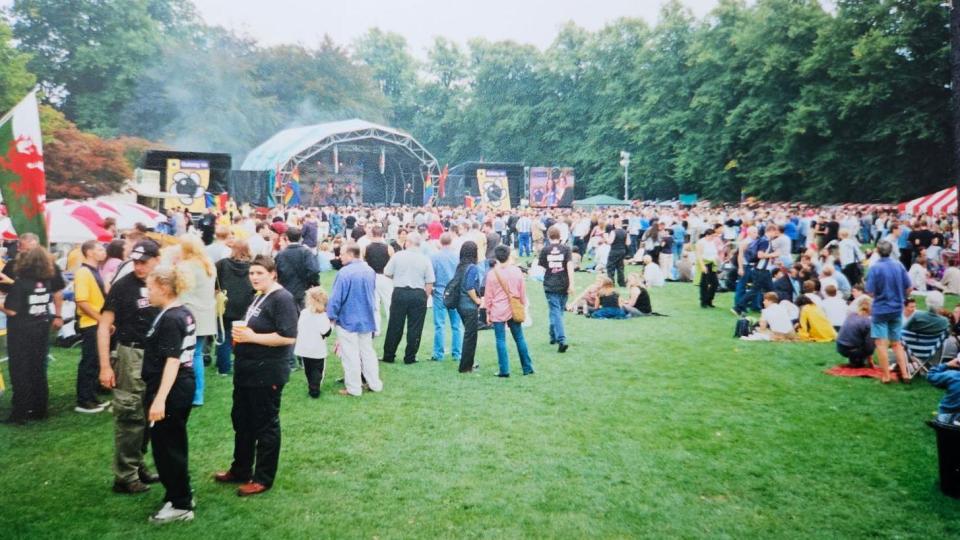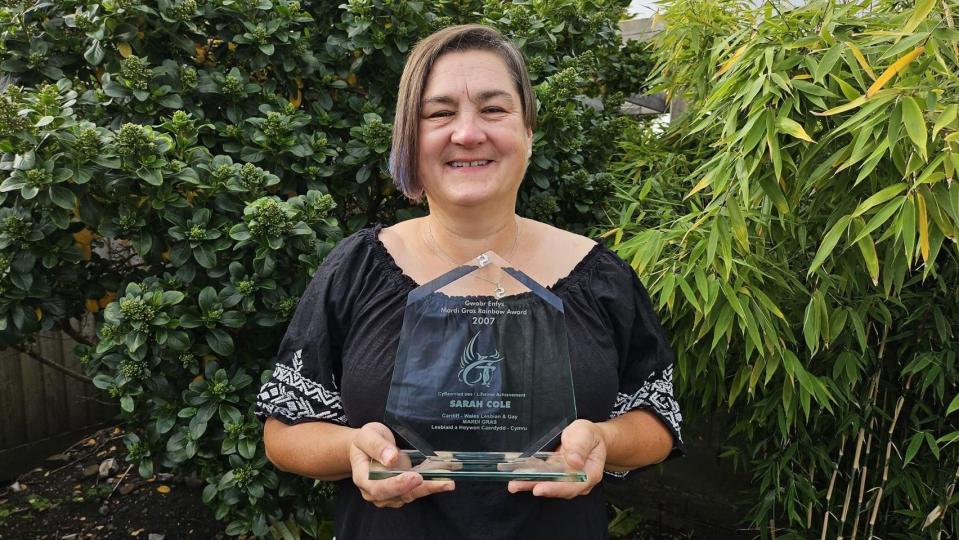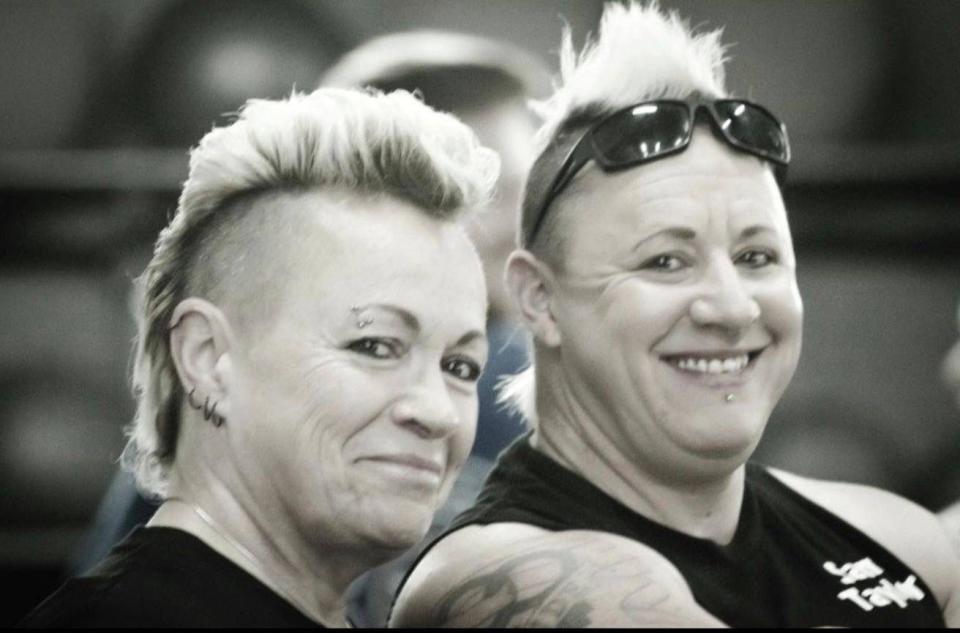From a stage in a lorry to party of 50,000
It's 1999 – teaching children about being gay is banned and same sex marriage is 15 years away, but one corner of Cardiff stages a celebration of all things LGBTQ+.
Wales' first Pride was modest, to put it mildly, with about 2,500 people and a stage "essentially the back of an articulated lorry," said drag artist Rob Keetch.
Now, a quarter of a century on, Cardiff Pride has grown to a two-day festival attracting tens of thousands.
"If you told me then that 25 years later we would go from 2,500 to 25,000 and now 50,000 I would have never believed you," said Rob.
The first Pride, on 4 September 1999, was held in Bute Park and was over and done with inside four hours.
Although there was no march or parade, Rob said it was about "celebrating who we are and how far we have come".
"I described it at the time as a party held by the gay community of Cardiff for the city of Cardiff."
He and another drag queen, Miss Kitty, were not meant to perform on the main stage, but a lull in proceedings meant they were thrust into the spotlight for a two-minute performance.
"We had no backing tracks or anything, but we took It’s Raining Men and we lip synced.
"But the crowd wanted more, so later we were able to go back on and did a little routine to a Steps medley along with our backing dancers."

He said he would have never have believed it would have got as big as it has.
Rob recalled, talking to Gordon, manager of Mary's Bar in Cardiff, in a frantic race to the front of the parade.
"He said 'do you remember when we turned up and there were two police officers, an ice cream van and drag queens in the back of the car and look now?'
"And I got really emotional, because if you had told me in 1999, when I was there in my gold catsuits that 25 years later I would be watching police officers, Army, Navy, Principality building society, Tesco, schools, all marching through Cardiff, I just couldn’t have imagined it.
"I was welling up, and Gordon looked at me and said, 'it’s because of work that people like you do', and I just hope it leads to more acceptance."

Rob went from performing at Pride Cymru to joining the committee and helping to organise it.
"We went from the circle of stones in the park, to then the field and then in 2013 we had it at the stadium.
"Then we went to the castle, and then to City Hall which was relatively successful and now we are back at the castle.
"And we now have the parade and march too."
Rob said the parade had become an intrinsic and powerful part of the weekend.
"People want to see the rainbows and the lesbians on the bikes and the drag queens.
"I don’t like to use this word but it normalises things, and shows people it is OK to be LGBTQ+."

Rob added: "This year there’s Newport, Barry, Abergavenny, Neath Port Talbot, all having their first prides, baby prides if you will, and those exist because of what we did 25 years ago.
"Ultimately I would love to see a day when we don’t need Pride, but when a couple who are holding hands in the city centre get attacked for who they are, and we are still having to fight for our rights and people aren’t able to live safely, that’s why it is needed."

He said one memory of the importance of Pride stuck out to him from around 2003-2004, when he was stopped on the field by a "six-foot brawny Scottish guy", who introduced Rob to his wife and son.
"His son must have been about 16 or 17, and had just come out as gay to them on the Wednesday of that week, and despite living in Scotland, they found out Cardiff Pride was happening that weekend and came down so their son could experience it and see people like him.
"That’s why I do Pride, so people can come along, parents with their children or people in their 70s, can be true to themselves and be who they are."
Rob is performing this year, celebrating 30 years of performing as Dr Bev Ballcrusher, and said there may be a special routine from that first Pride.

Sarah Hemsley-Cole, 53, was part of the team that set up the first Pride Cymru.
"It came about because we wanted to create a more visual presence of the gay and lesbian community.
"I feel incredibly proud of what we achieved."
She said people attended the event who were not out and that was a real reality of how people lived.
"There were no references on telly. There was London and Manchester, and I think Brighton and that was it.
"For us to create this in Cardiff was huge and it meant there was a way for the community to celebrate themselves in a more public and visual way."
She added Pride had changed in the past 25 years.
"It isn’t necessarily the same agenda, the LGBTQ+ community is much broader and wider, identities have swelled and Pride has been able to embrace those transitions."
Mark Etheridge, principle curator of collection development: LGBTQ+ at Museum Wales, said people would have to leave Wales to attend a Pride event before 1999.
and said prior to 1999 anyone in Wales would have to go to London or outside of the country to attend a Pride event.
“There was a Pride march in 1985 that was organised by Cardiff University gay society and was attended by about 30 people.
"But the first celebratory event was in 1999, which was the Cardiff Lesbian and Gay Mardi Gras – and that was organised because of hate crime.”
What is Pride?
Pride is a global movement fighting for equal rights for LGBT people all over the world
It is a celebration of people coming together in love and friendship, to show how far LGBTQ+ rights have come and how in some places there is work still to be done
He said a march was added in 2012 and the name was changed to Pride Cymru in 2014.
"Today, there are Pride events all over Wales and we can celebrate in our local communities," he said.
Sam Taylor, a gay woman from Aberdare, Rhondda Cynon Taf, attended Pride in the early 2000s when it was a free event.
"It was brilliant, and just really exciting that it was happening here.
"With the huge Mardi Gras’ happening in London it felt really exciting. Being gay felt still quite underground so to have something of our own rather than having to travel was just great."
The 46-year-old said Pride had "changed loads" but it was important to understand its history.
"People have sacrificed so much, it is a celebration but we have to remember the people before us and the meaning behind it.
“It’s fantastic it is still going 25 years on, and in the current climate we are in I think that having Pride is very important."

Chair of Pride Cymru, Gian Molinu said: "Looking back over 25 years, the progress that has been made in advancing LGBTQ+ equality is vast.
"When this event first started, there was no equal marriage, no adoption rights and the cruel Section 28 was still in force.
"Pride is an opportunity to come together for us to celebrate the achievements of activists but also to fight for further action where there is still progress to make.
"In the last few years, there has been a worrying creeping trend towards using LGBTQ+ lives to score political points and divide communities."

